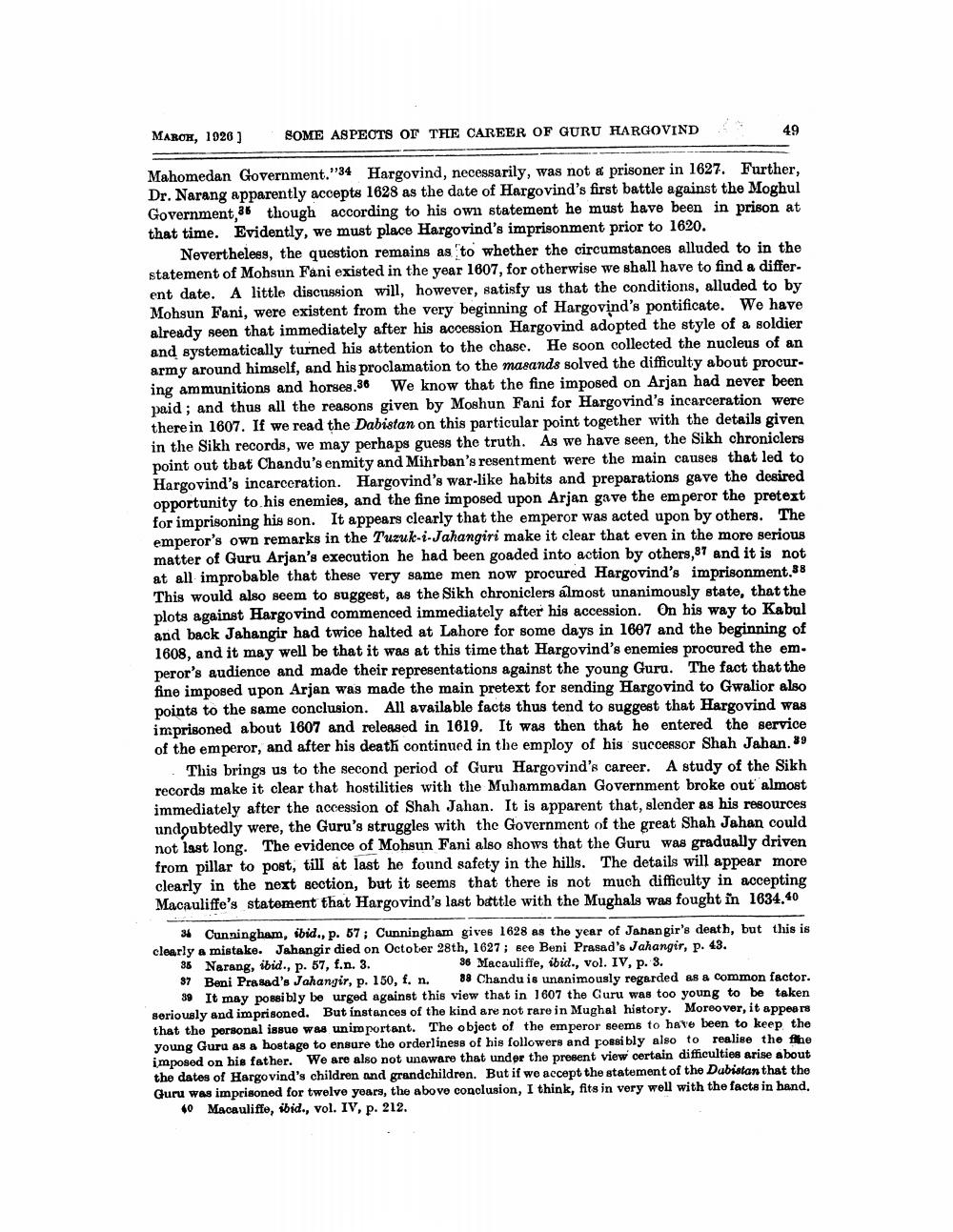________________
MAROH, 1026 )
SOME ASPECTS OR THE CAREER OF GURU HARGOVIND
49
Mahomedan Government."34 Hargovind, necessarily, was not a prisoner in 1627. Further. Dr. Narang apparently accepts 1628 as the date of Hargovind's first battle against the Moghul Government, 36 though according to his own statement he must have been in prison at that time. Evidently, we must place Hargovind's imprisonment prior to 1620.
Nevertheless, the question remains as to whether the circumstances alluded to in the statement of Mohsun Fani existed in the year 1607, for otherwise we shall have to find a differ. ent date. A little discussion will, however, satisfy us that the conditions, alluded to by Mohsun Fani, were existent from the very beginning of Hargovind's pontificate. We have already seen that immediately after his accession Hargovind adopted the style of a soldier and systematically turned his attention to the chase. He soon collected the nucleus of an army around himself, and his proclamation to the masands solved the difficulty about procuring ammunitions and horses.36 We know that the fine imposed on Arjan had never been paid; and thus all the reasons given by Moshun Fani for Hargovind's incarceration were there in 1607. If we read the Dabistan on this particular point together with the details given in the Sikh records, we may perhaps guess the truth. As we have seen, the Sikh chroniclers point out that Chandu's enmity and Mihrban's resentment were the main causes that led to Hargovind's incarceration. Hargovind's war-like habits and preparations gave the desired opportunity to his enemies, and the fine imposed upon Arjan gave the emperor the pretext for imprisoning his son. It appears clearly that the emperor was acted upon by others. The emperor's own remarks in the Tuzuk-i-Jahangiri make it clear that even in the more serious matter of Guru Arjan's execution he had been goaded into action by others, 87 and it is not at all improbable that these very same men now procured Hargovind's imprisonment.88 This would also seem to suggest, as the Sikh chroniclers almost unanimously state, that the plots against Hargovind commenced immediately after his accession. On his way to Kabul and back Jahangir had twice halted at Lahore for some days in 1607 and the beginning of 1608, and it may well be that it was at this time that Hargovind's enemies procured the em. peror's audience and made their representations against the young Guru. The fact that the fine imposed upon Arjan was made the main pretext for sending Hargovind to Gwalior also points to the same conclusion. All available facts thus tend to suggest that Hargovind was imprisoned about 1607 and released in 1619. It was then that he entered the service of the emperor, and after his death continued in the employ of his successor Shah Jahan. 39
This brings us to the second period of Guru Hargovind's career. A study of the Sikh records make it clear that hostilities with the Muhammadan Government broke out almost immediately after the accession of Shah Jahan. It is apparent that, slender as his resources undoubtedly were, the Guru's struggles with the Government of the great Shah Jahan could not last long. The evidence of Mohsun Fani also shows that the Guru was gradually driven from pillar to post, till at last he found safety in the hills. The details will appear more clearly in the next section, but it seems that there is not much difficulty in accepting Macauliffe's statement that Hargovind's last battle with the Mughals was fought in 1634.40
34 Cunningham, ibid., p. 57; Cunningham gives 1628 as the year of Janangir's death, but this is clearly a mistake. Jahangir died on October 28th, 1627; see Beni Prasad's Jahangir, p. 43. 35 Narang, ibid., p. 57, f.n. 3.
36 Macauliffe, ibid., vol. IV, p. 3. 87 Beni Prasad's Jahangir, p. 150, f. n. 88 Chandu is unanimously regarded as a common factor.
39 It may possibly be urged against this view that in 1607 the Curu was too young to be taken seriously and imprisoned. But instances of the kind are not rare in Mughal history. Moreover, it appears that the personal issue was unimportant. The object of the emperor seems to have been to keep the young Guru as a hostage to ensure the orderliness of his followers and possibly also to realise the fthe imposed on his father. We are also not unaware that under the present view certain difficulties arise about the dates of Hargovind's children and grandchildren. But if we accept the statement of the Dabistan that the Guru was imprisoned for twelve years, the above conclusion, I think, fits in very well with the facts in hand.
40 Macauliffe, ibid., vol. IV, p. 212.




